商务英语视听教案.doc
- 格式:doc
- 大小:73.00 KB
- 文档页数:4

《商务英语视听说》下册教案5授课章节名称:Unit Two 教材逻辑结构分析和学生分析:In this period, the students are supposed to learn the expressions about establishing business relationships and product promotion; they will watch a video about consulting about trade fairs. 教学目的:1.Know how to establish business relationships;2.Get to know how to promoting products;教学重点:How to act as a buyer or an exhibiter in a trade fair.教学难点:How to make a brief introduction of a factory or a company.更新、补充及删节内容:Ask the students to get more information about word famous trade fairs 教学方法与使用教具:Task-based teaching;Tape-recorderTeaching procedures:Step 1 Leading in1. Revise the famous trade fairs of China.Step 2 PresentationLanguage Focus AUseful expressions at trade fairsA.Greeting at trade fairs How do you do?Hello! You are welcome!I'm glad to see you.Nice to meet you.Good morning! Welcome to our stand.B.Introducing each other at trade fairs Let me introduce you to Mr. Li, General Manager of our company.It's an honour to meet you. My name is Thomas Clinton.rd like to make a self-introduction. Tm Richard Carter, Sales Manager of BIM.How do I prononce your name?How do I adress you?What line of business are you in?C.Negotiating at trade fairs While we appreciate your interest, we're very sorry to say that we can't reduce our price any further.We are satisfied with the quality of your samples, so business will depend entirely on your price.To a certain extent, our pruce depends on the size of your order.This product is now in great demand and we have in hand many enquiries from other countries.Thank you for your enquiry. Would you tell us what quantity you require so we can work out the offer?My offer was based on reasonable profit, not on wild speculations.D.Farewells Thank you for coming to our stand. You are welcome to our company if you want to know more about us.Nice meeting you. Please give us a call if you need more information about our products.Goodbye! Keep in touch.See you next time!See you later!1.Follow-up PracticePlay the tape and get the students to listen to the AsiaWorld-Expo and fill in the blanks on page 17.A.Check the answers.B.Ask the students to listen to the dialogue between Mr. Li and Mr. Brown in theExhibition Hall at the China Export Commodities Fair and choose the best answer to each question.C.Check the answers.2.Video 1A.Get the students to look at the pictures on page 18 to have a rough idea of the video.B.Ask the students to watch the video and identify who is the speaker of each of thesentences on page 18.C.Check the answers.D.Ask the students to watch the video again and choose the correct answer to eachquestions on page 19E.Check the answers.3.Post-viewingGet the students to work in groups to rank the importance of the seven steps considered important for planning a trade show. Exchange ideas and give explanations to their group members.a.select a trade fair carefullyb.Set a realistic budgetc.carry out advertising and publicityd.design the stande.train the exhibit stafff.schedule the timeg.select exhibits carefullyStep 3 Consolidation and Assignment(1)Get the Ss to read aloud the expressions about establishing business relationships andproduct promotion.(2)Assignment: Try to make a conversation about a seller and a buyer in the trade fair,you should use the expressions you have learned in this part.。
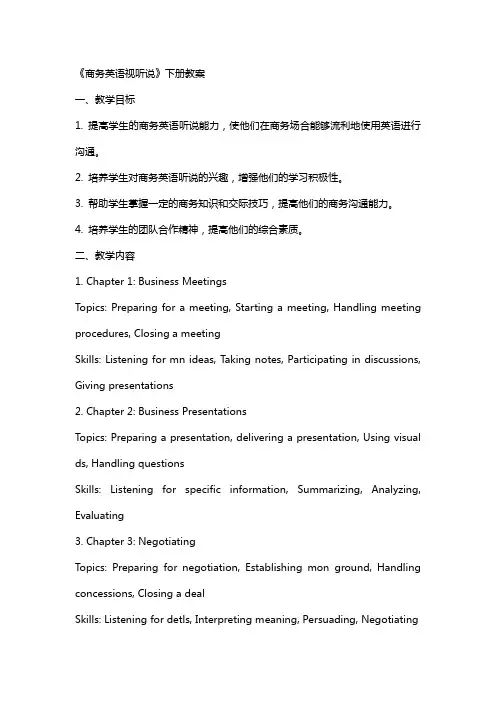
《商务英语视听说》下册教案一、教学目标1. 提高学生的商务英语听说能力,使他们在商务场合能够流利地使用英语进行沟通。
2. 培养学生对商务英语听说的兴趣,增强他们的学习积极性。
3. 帮助学生掌握一定的商务知识和交际技巧,提高他们的商务沟通能力。
4. 培养学生的团队合作精神,提高他们的综合素质。
二、教学内容1. Chapter 1: Business MeetingsTopics: Preparing for a meeting, Starting a meeting, Handling meeting procedures, Closing a meetingSkills: Listening for mn ideas, Taking notes, Participating in discussions, Giving presentations2. Chapter 2: Business PresentationsTopics: Preparing a presentation, delivering a presentation, Using visual ds, Handling questionsSkills: Listening for specific information, Summarizing, Analyzing, Evaluating3. Chapter 3: NegotiatingTopics: Preparing for negotiation, Establishing mon ground, Handling concessions, Closing a dealSkills: Listening for detls, Interpreting meaning, Persuading, Negotiating4. Chapter 4: Teleconferences and Video ConferencesTopics: Setting up a teleconference, Participating in a video conference, Using technology effectively, Handling technical problemsSkills: Listening over the phone, Non-verbal munication, Adapting to different munication styles5. Chapter 5: Business CorrespondenceTopics: Writing business letters, Writing es, Formatting documents, Proofreading and editingSkills: Listening for relevant information, Summarizing, Writing clearly and concisely, Proofreading三、教学方法1. 任务型教学法:通过模拟商务场景,让学生在实际操作中练习商务英语听说能力。
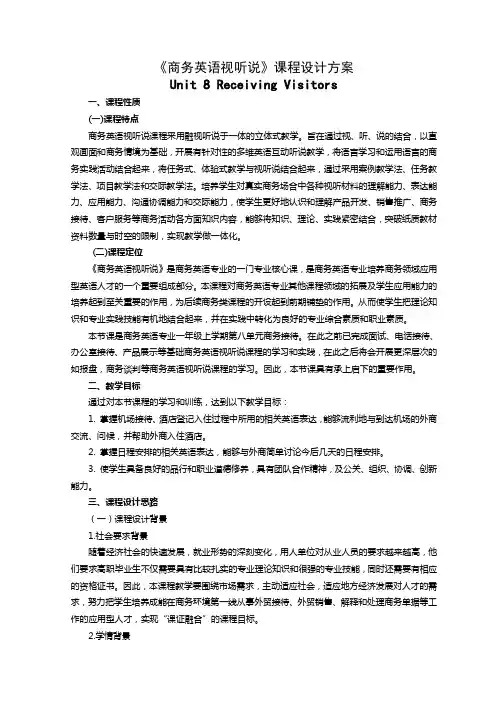
《商务英语视听说》课程设计方案Unit 8 Receiving Visitors一、课程性质(一)课程特点商务英语视听说课程采用融视听说于一体的立体式教学。
旨在通过视、听、说的结合,以直观画面和商务情境为基础,开展有针对性的多维英语互动听说教学,将语言学习和运用语言的商务实践活动结合起来,将任务式、体验式教学与视听说结合起来,通过采用案例教学法、任务教学法、项目教学法和交际教学法。
培养学生对真实商务场合中各种视听材料的理解能力、表达能力、应用能力、沟通协调能力和交际能力,使学生更好地认识和理解产品开发、销售推广、商务接待、客户服务等商务活动各方面知识内容,能够将知识、理论、实践紧密结合,突破纸质教材资料数量与时空的限制,实现教学做一体化。
(二)课程定位《商务英语视听说》是商务英语专业的一门专业核心课,是商务英语专业培养商务领域应用型英语人才的一个重要组成部分。
本课程对商务英语专业其他课程领域的拓展及学生应用能力的培养起到至关重要的作用,为后续商务类课程的开设起到前期铺垫的作用。
从而使学生把理论知识和专业实践技能有机地结合起来,并在实践中转化为良好的专业综合素质和职业素质。
本节课是商务英语专业一年级上学期第八单元商务接待。
在此之前已完成面试、电话接待、办公室接待、产品展示等基础商务英语视听说课程的学习和实践,在此之后将会开展更深层次的如报盘,商务谈判等商务英语视听说课程的学习。
因此,本节课具有承上启下的重要作用。
二、教学目标通过对本节课程的学习和训练,达到以下教学目标:1. 掌握机场接待、酒店登记入住过程中所用的相关英语表达,能够流利地与到达机场的外商交流、问候,并帮助外商入住酒店。
2. 掌握日程安排的相关英语表达,能够与外商简单讨论今后几天的日程安排。
3. 使学生具备良好的品行和职业道德修养,具有团队合作精神,及公关、组织、协调、创新能力。
三、课程设计思路(一)课程设计背景1.社会要求背景随着经济社会的快速发展,就业形势的深刻变化,用人单位对从业人员的要求越来越高,他们要求高职毕业生不仅需要具有比较扎实的专业理论知识和很强的专业技能,同时还需要有相应的资格证书。
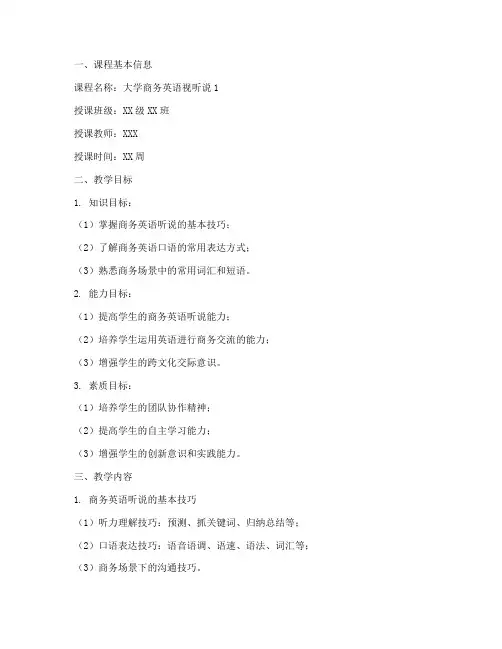
一、课程基本信息课程名称:大学商务英语视听说1授课班级:XX级XX班授课教师:XXX授课时间:XX周二、教学目标1. 知识目标:(1)掌握商务英语听说的基本技巧;(2)了解商务英语口语的常用表达方式;(3)熟悉商务场景中的常用词汇和短语。
2. 能力目标:(1)提高学生的商务英语听说能力;(2)培养学生运用英语进行商务交流的能力;(3)增强学生的跨文化交际意识。
3. 素质目标:(1)培养学生的团队协作精神;(2)提高学生的自主学习能力;(3)增强学生的创新意识和实践能力。
三、教学内容1. 商务英语听说的基本技巧(1)听力理解技巧:预测、抓关键词、归纳总结等;(2)口语表达技巧:语音语调、语速、语法、词汇等;(3)商务场景下的沟通技巧。
2. 商务英语口语常用表达方式(1)自我介绍;(2)商务场合的寒暄;(3)商务会议、谈判、电话沟通等场景下的常用表达。
3. 商务英语常用词汇和短语(1)商务场景中的常用词汇;(2)商务英语中的常用短语和句型。
四、教学方法1. 讲授法:教师通过讲解,帮助学生掌握商务英语听说的基本技巧和常用表达方式;2. 案例分析法:通过分析实际商务场景中的对话,让学生了解商务英语口语的表达方式;3. 角色扮演法:让学生分组进行角色扮演,提高学生的实际商务沟通能力;4. 小组讨论法:引导学生围绕特定话题进行讨论,培养学生的团队协作精神;5. 课后自主学习:布置课后作业,要求学生通过查阅资料、观看视频等方式,巩固所学知识。
五、教学进度安排第1周:商务英语听说的基本技巧第2周:商务英语口语常用表达方式第3周:商务英语常用词汇和短语第4周:商务场景下的沟通技巧第5周:角色扮演第6周:小组讨论第7周:课程总结与评估六、教学评价1. 课堂表现:包括学生的出勤、参与度、合作精神等;2. 课后作业:检查学生的课后学习效果;3. 角色扮演和小组讨论:评估学生的实际商务沟通能力;4. 期末考试:测试学生的商务英语听说能力。

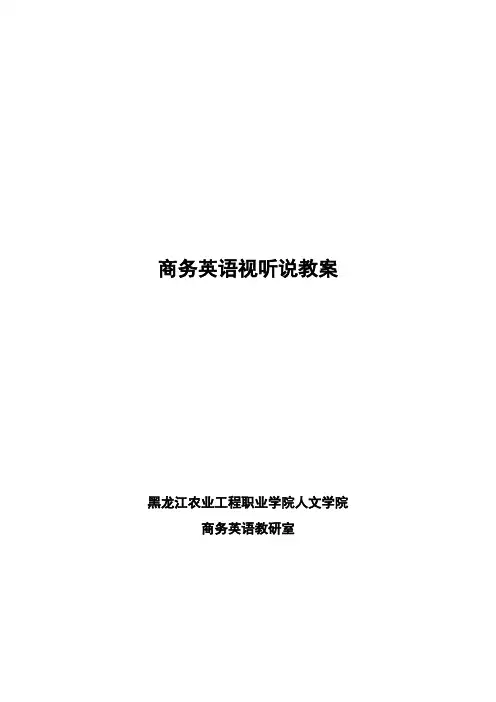

《商务英语视听说》下册教案第一章:商务英语听说基础1.1 教学目标能够使用基本的商务英语词汇和句型进行日常交流。
能够理解和使用商务场景中的常见表达和礼貌用语。
1.2 教学内容商务英语的基本词汇和句型。
商务场景中的常见表达和礼貌用语。
1.3 教学方法通过听力练习和口语练习来提高学生的听说能力。
使用情景模拟和角色扮演来练习商务场景中的交流。
1.4 教学评估通过听力测试和口语测试来评估学生的学习效果。
第二章:商务电话沟通2.1 教学目标能够使用英语进行商务电话沟通,包括拨打电话和接听电话。
能够理解和使用商务电话沟通中的常见表达和技巧。
2.2 教学内容商务电话沟通的基本原则和技巧。
商务电话沟通中的常见表达和礼貌用语。
2.3 教学方法通过听力练习和口语练习来提高学生的电话沟通能力。
使用模拟电话交流情景来进行角色扮演练习。
2.4 教学评估通过模拟电话交流测试来评估学生的学习效果。
第三章:商务会议交流3.1 教学目标能够使用英语进行商务会议交流,包括会议准备和会议进行中的沟通。
能够理解和使用商务会议交流中的常见表达和技巧。
3.2 教学内容商务会议交流的基本流程和技巧。
商务会议交流中的常见表达和礼貌用语。
3.3 教学方法通过听力练习和口语练习来提高学生的会议交流能力。
使用模拟会议情景来进行角色扮演练习。
3.4 教学评估通过模拟会议交流测试来评估学生的学习效果。
第四章:商务谈判技巧4.1 教学目标能够使用英语进行商务谈判,包括谈判准备和谈判过程中的沟通。
能够理解和使用商务谈判中的常见表达和技巧。
4.2 教学内容商务谈判的基本原则和技巧。
商务谈判中的常见表达和礼貌用语。
4.3 教学方法通过听力练习和口语练习来提高学生的谈判能力。
使用模拟谈判情景来进行角色扮演练习。
4.4 教学评估通过模拟谈判测试来评估学生的学习效果。
第五章:商务演讲与报告5.1 教学目标能够使用英语进行商务演讲和报告,包括演讲准备和报告呈现。
能够理解和使用商务演讲和报告中的常见表达和技巧。
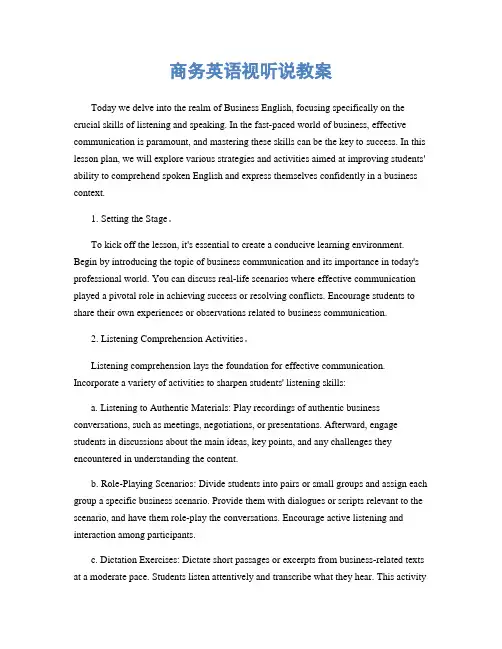
商务英语视听说教案Today we delve into the realm of Business English, focusing specifically on the crucial skills of listening and speaking. In the fast-paced world of business, effective communication is paramount, and mastering these skills can be the key to success. In this lesson plan, we will explore various strategies and activities aimed at improving students' ability to comprehend spoken English and express themselves confidently in a business context.1. Setting the Stage。
To kick off the lesson, it's essential to create a conducive learning environment. Begin by introducing the topic of business communication and its importance in today's professional world. You can discuss real-life scenarios where effective communication played a pivotal role in achieving success or resolving conflicts. Encourage students to share their own experiences or observations related to business communication.2. Listening Comprehension Activities。
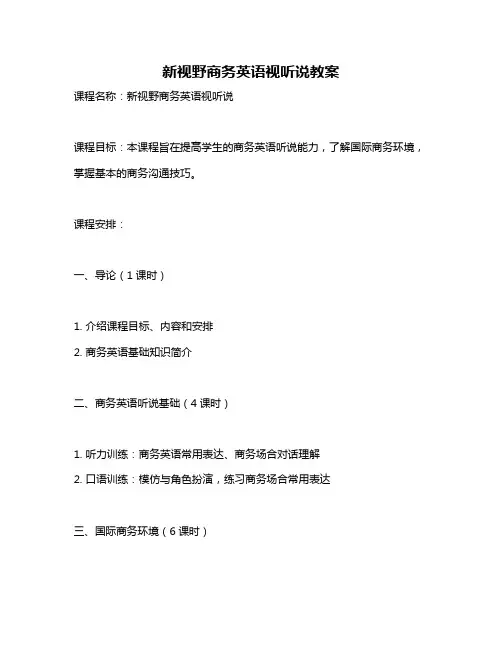
新视野商务英语视听说教案
课程名称:新视野商务英语视听说
课程目标:本课程旨在提高学生的商务英语听说能力,了解国际商务环境,掌握基本的商务沟通技巧。
课程安排:
一、导论(1课时)
1. 介绍课程目标、内容和安排
2. 商务英语基础知识简介
二、商务英语听说基础(4课时)
1. 听力训练:商务英语常用表达、商务场合对话理解
2. 口语训练:模仿与角色扮演,练习商务场合常用表达
三、国际商务环境(6课时)
1. 国际贸易基础知识
2. 跨国公司运营与管理
3. 国际商务礼仪与习俗
4. 文化差异与跨文化沟通
四、商务沟通技巧(6课时)
1. 商务谈判技巧与策略
2. 商务演讲技巧与演示文稿制作
3. 书面沟通技巧:商务邮件、报告撰写
4. 客户沟通与服务技巧
五、实践环节(2课时)
1. 模拟商务场景,分组进行角色扮演与模拟谈判等实践操作
2. 总结与反思,根据实践环节的表现进行评估与反馈
教学方法:采用多媒体教学,结合视频、音频、图片等资料,通过讲解、示范、小组讨论、角色扮演等多种方式进行教学。
同时,鼓励学生自主学习,利用网络资源进行拓展学习。
教学资源:课程教材、多媒体课件、商务英语视频材料、在线学习资源等。
评估方式:本课程采用综合评估方式,包括平时成绩和期末考试成绩两部分。
平时成绩包括课堂参与度、小组讨论表现、角色扮演表现等;期末考试成绩包括听力、口语和阅读理解等部分的测试。

商务英语视听说课程设计摘要:基于工作过程导向的课程开发是高等职业教育的课程开发和改革方向。
本文从商务英语专业就业岗位群分析入手,为课程设计奠定实践基础。
通过分析职位,总结出五个典型工作任务大类,并细化分解为十四个子实训单元,以此为依据从整体和局部设计了“商务英语视听说”课程。
关键词:工作过程;课程设计;能力目标1“商务英语视听说”课程设计的理论基础及设计思路1.1“商务英语视听说”课程设计的理论基础“商务英语视听说”课程设计的理论基础是依据姜大源教授提出的“基于工作过程系统化”的课程开发理论。
该理论通过四个阶段来开发适合高等职业院校学生学习的课程:“工作任务分析”、“行动领域归纳”、“学习领域转换”、“学习情境设计”四个阶段。
①由最初的工作岗位调查,过渡到分析目标岗位的典型工作任务、设置课程门类,到最后的教学设计与实施,将工作过程分析延伸至教学过程分析,是一整套基于工作过程系统化的课程开发方法。
1.2“商务英语视听说”课程的设计思路根据该理论,课程开发首要任务是调研专业对应的工作岗位及岗位群,与行业专家分析岗位工作能力,根据复杂程度整合典型工作任务形成能力领域,根据职业定律将能力领域转换为课程,以项目为载体设计学习单元。
考虑到商务英语专业学生的工作任务主要集中在商务与英语的结合处,学生需要具备良好的商务知识和英语听说技能,笔者选取了“商务英语视听说”作为课程载体,将分解的工作任务(行动领域)转换为学习领域。
并据此设计“商务英语视听说”课程的模块化教学安排。
2商务英语专业的就业岗位群分析2.1商务英语专业的就业岗位群分析笔者对天津商务职业学院2010-2018届部分商务英语专业毕业生的就业岗位群及岗位工作任务进行了调查,采用问卷与访谈相结合的方式。
调查结果显示:将近30%的毕业生流向了天津外向型企业,从事商务助理及商务文员的工作。
天津地区的外向型、劳动密集型企业数量众多,集中在纺织服装、机械制造、玩具、日用品和加工行业,企业中一般都配备一定数量的商务助理及商务文员。

新视野商务英语视听说(上)授课教师:李殿文Unit 1 Job interviewTeaching objectiveAfter completing this lesson, students should know how to deal with an interview, including-- how to prepare for an interview-- the interview procedure-- how to answer questions about personal details,education and work experiencehow to deal with inappropriate questions by the interviewer.Business profileGeneral conduct during an interviewOpening :establishing a friendly atmosphereIntroduce yourselfTalk about weather, traffic ,etc.Talk about yourself as a personDuring :exchanging informationGeneral questionsBe prepared to talk aboutYour personal detailsYour educationYour work experiencePosition related questionsYou will be able to discussReasons for leaving last jobDetails of the job and the companyQualifications and skills make you fit for the requirements of the job Short-term goals and long term goalsClosing : leaving a lasting impressionAsk 1 or 2 questions based on your pre-interview researchArrange a call back to get the resultThank the interviewerSay you enjoyed the interviewTypes of job interviewTelephone screening interviewIn-person screening interviewSelection interviewWork sample interviewPeer group interviewGroup interviewLuncheon interviewStress interviewVideoconference interviewTeaching planPart 1 warm-upOrganizational structure of the companyName of the interviewerDivision/departments that interest youProducts/servicesTraining programsSize of the company-number of employees and turnover How long they have been in businessTypes of clientsGrowth in the past and future potentialJob description and job titleAppearanceDress conservatively: smart, clean and formalDo have clean, neatly styled hairDo have clean hands and trimmed nailsDo carry a portfolio or briefcase with extra copies of your resume Do bring a clean notepad and pen that worksDo wear shoes you can walk easily inDon’t wear torn, soiled, wrinkled clothingDon’t dress casuallyAppearanceDon’t wear a lot of jewelry (men should avoid earrings)Don’t wear a lot of cologne or perfumeDon’t wear sports shoesDon’t eat spicy, offensive smelling foods before the interview Don’t wear sexy clothingDon’t wear cutesy ties (flashing Micke y mouse)Don’t chew gum or smokeDon’t wear a mini-skirtDon’t wear heavy make-upPart 2 Listening practiceTask I and task 2Listen--- finish – readPart 3 language focus AOpeningDuringPersonal questionsEducationWork experienceFollowing-up practiceListen and readPart 4 Video 1 Watch –finish –role play Part 5 language focus BPosition related questions Qualifications and skillsJob fitClosingFollowing-up practicePart 6 Video 2 watch and fillhomeworkDialogue :interviewpg. 12 MP3Unit 2 jobs and responsibilities Teaching objectivesAfter completing this lesson, students should be able to--- describe jobs and responsibilities--- describe their position and responsibilities in a company --- describe a company’s organization--- express likes and dislikes about jobsBusiness profileWant to know about jobs and responsibilities in a company?Senior sales managerFinancial controllerHuman resources managerLogistics managerAccount managerPurchaser/buyerLanguage expansionsJobsResponsibilitiesPositions and the departmentsWorking hours and routinesInterpersonal relationshipCompensationPromotionJob satisfactionTeaching planPart 1 warm upWaiter farmer carpenter photographer electricianChef/cook typist policeman doctor singerPart 2I’m a manager in the human resources departmentWhich company do you work for?I’m mainly in charge of recruitment, that is, the selection, training and development of employeesI haven’t seen for you yearsWhat do you do nowWhat are you working onF T F F F TPart 31.card 1 company: Beijing sanmei factory name: alice wang title:manager of human resources2.card 2 company bill hayes title general manager companybeautify cosmetic corporationpart 41.caroline Clinton--- financial accounts2.lucy white--- data processing3.ada black—management accountspart 5chef editor magazine manage feedbackdefinite flexible office regularC A F E B G DSelf-employed entrepreneurBuyer line supervisorAdvertising executivePublic relations managerHomeworkWriting : imagine your ideal job and describe the responsibilities of it . if needed, you can search information from internet.Unit 3 On the phoneTeaching objectivesAfter completing this lesson, students should be able toAnswer the phoneAsk to be connectedConnect a callerLeave messagesDeal with problems b telephoneBusiness profileThe big 31.be prepared2.don’t give up3.try not to put people on the spotbefore you pick up a phone1.review written material first2.make a list of questions for each encounter3.be clear about what information you need4.establish a system for yourself5.create a notebook or other organizer6.psych yourself to make the call7.make calls when you’re at your best making your calls1.be aware of the pitch of your voice2.be modest3.establish a relationship4.avoid yes or no question5.be empathetic6.make the personal feel like your mentor7.find out his /her schedule8.be polite9.always get the name of the person10.remember we still don’t have videophonestypes of callanswering the phoneintroducing yourselfasking for someoneputting someone on holdthe person wanted is not availabletaking a messageringing offproblemsreasons for callingrequestingteaching planpart 1 warm-upadvance documents schedule distraction pretend interrupting clearly argue polite lengthy misunderstood hearPart 2 listening practiceB E G F D A CSimon Weller is calling from Singapore He has just left for a workshopHalf an hour laterPart 3Part 4F T F TT FPart 51. 875-93682. 305-636-84303. 5312/A124. Bartholomew5. holt &frier6. dinerPart 6A C C CB CHOMEWORKMake a telephone call and telephone messageUnit 4 At a meetingTeaching objectivesAfter completing this lesson, students should be able toUnderstand and use vocabulary related to meetingsIdentify and understand basic aspects of planning a meeting Effectively use communication skills toChair a meetingAsk for and giving opinionsAgree the disagree with an ideaMake suggestionBusiness profileSample board of directors meeting agendaName of agency board meeting agendaMonth day yearLocationPlanned starting time to ending timeSample of minutes of a management meeting Name of organizationMeeting mintues: month day yearTime and locationPresent:ProceedingUseful expressionInterruptingGiving opinionCommenting on other opinionsAgreeing with other opinionsDisagreeing with other opinionsClarifyingRequesting informationAsking for repetitionAsking for clarificationAsking for verificationAsking for contributions of other participantsCorrecting informationKeeping the meeting on timeTeaching planPart 1 work in pairsPart 2List agenda minutes decision collect topic write arrange invite Before a meeting 2 6 8 9During a meeting 4 5 7After a meeting 1 3Purpose argue written agenda chairperson late waitingToo much dealt with decision take notes discussionT T F F TPart 3Conversation 1. eConversation 2 cConversation 3 aConversation 4 bConversation 5 fConversation 6 hPart 4Sharp august should not GregoryPart 5B BHomework1. a laundry2.print and photo service3.translation and interpretation service4. a bookstoreUnit 5 Business TravelTeaching objectivesAfter completing this lesson, student should be able to;---understand and use basic travel-related vocabulary---understand procedures related to checking-in, clearing customs and checks at the airport---effectively use communication skills to:Enquire about flightsReserve airplane ticketEnquire about facilities and services in a hotelBook a hotel roomRequest services in a hotelBusiness profileMaking enquiries about flights, luggage, and check-in times Booking airline ticketsChecking in at the airportGoing through customsMaking a reservation in a hotelChecking in at a hotelChecking outTeaching planPart 1a f g j ebc od hpart 2g a e b d f h I j l n r q p o k cin a taxi at a hotel on an airplane at customs in a booking office reserve a room check for rather fullticket and passport boarding passport tagsroom service plain blackdeclare subject to belongingscheck out comes to receiptpart 3seats c and d row 12two20 kilos gate 7 nowPart 4F t f f f f t tPart 5From January 15th to 18thNo there isn’tBy credit cardHe is booking a small conference roomHe is asking for a wake-up call for tomorrow morningApproximately 8 hoursThe price for a single room with garden view is us 150, and that for a similar room with rear view 125HomeworkUnit 6 company presentationsTeaching objectivesAfter completing this lesson, students should be able toUnderstand and use basic vocabulary for introductions and presentations Identify the structure of a company presentationEffectively use communication skills toTalk about a company profileAnswer general questions about a companyGive a brief self-introductionGive a short business presentationBusiness profileOrganization of the informationDelivery of the informationUse of languageAudienceParticipationTypes of companyCompany corporationFirmEnterpriseTownship enterpriseState-own enterprisePrivately-owned enterpriseWholly owned foreign enterpriseForeign capital enterpriseSino-foreign joint ventureMultinational corporationGroup corporationLimited corporationParent companySubsidiary affiliate companyPartnershipShare holding companyListed quoted companyCooperationIndustrial corporationConsulting corporationTeaching planPart one warm-upPart 2Products leading global first connecting London carAddress audience PR department information china 2 5 minutes Largest first china 1977 california42000 11 billion 1989Part 3Internal presentation A D F G I LExternal presentation B C E H J KPart 4A c d e f gPart 5COpenHomeworkUnit 7 product presentationsTeaching objectivesAfter completing this lesson, students should be able toUnderstand and use basic vocabulary to describe products and make presentationsIdentify the structure of a product presentationsEffectively use communication skills toDescribe a productCompare the features of productsAsk for information about productsMake a short presentationBusiness profileCreating a product objectiveDifferent depending upon the target audience and the presentation should be adjusted accordingly.An important part of selling a product to prospective customers.Points to considerObjectiveTarget audienceTarget presenterOutlineIntroductionPositioningProduct descriptionExamples successClosing argumentWhen you are the presenterPractice your presentationOther helpful hintsUse gesturesUse an expressive voiceAlways standsUse highlights or color or chartsUse controversyUse metaphors to help with visualizationLanguage expansionGiving general information about a product Describing the quality and performance Describing the styleDescribing the craftsmanship and workmanshipTeaching planPart 1 warm-upPart 2 listening practiceMegabyte ounce pound kilogram inchCentimeter hour year month footLower better more good longer shorterPart 3B414 small black design easy 12 48 5Part 5C b cHomeworkUnit 8 receiving visitorsTeaching objectivesAfter completing this lesson, students should be able toUnderstand the procedures when receiving business visitors Effectively use communication skills toReceive business visitors who have an appointmentReceive business visitors who do not have an appointmentMeet visitors at the airportParticipate in small talk about travel ,weather or accommodationBusiness profileReceptionistThe workMost organizations employ receptionists. For example hotels, factories, hospitals, school. Etc.Skills and interestsBe outgoing and confidentHave a smart appearanceHave good communication skillsBe able to stay calm under the pressureBe courteous, but firmBe efficient and well organizedBe able to work on your ownHave basic computer skillsBe able to use office equipmentBe interested in the work of the organizationLanguage expansionReceiving visitors at the officeAsking for names identification of the visitorsAsking the purpose of the visitAsking the visitor to waitAsking the visitor for informationGiving the visitor informationApologizing for having kept the visitor waitingExpressing regret then someone is not present Meeting guests at the airportTaking guests to their hotelSmall talk topicSeeing offTeaching planPart 1 openPart 2C f a I b h d e j gA BCE BD AC CD BDF F F T F TPart 3Make an appointment in the middle ofBy name in touch withMake suggestions out of the questionE G A C L D HK J B M I/N F N/IPart 4F T F T T TPart 5F F F F FF T F T FHomeworkUnit 9 business dinnerTeaching objectivesAfter completing this lesson, students should be able to Understand and use basic dinner-related vocabularyEffectively use some communication skills toInvite business associates to dinnerOrder western foodOrder Chinese foodComment on foodPropose a toast during a dinnerBusiness profileBasic table mannersManners in every country are different. What is polite in China may not be polite in the United States. These basic rules will help you enjoy western food with your American friends.Always put the napkin on your lap first. Before you leave the table, fold your napkin and put it beside your plate.As the meal is served, use the silverware farthest from the plate first. When eating something in a bowl, do not leave the spoon in the bowl. Put it on the plate beneath the bowl. Soup, as well as all American food is eaten quietly. Do not slurp the soup. The soup spoon is used by moving the spoon away from you. Do not over fill the spoon. The bowl may be tipped slightly away from you to allow the last bit of soup to be collected on the spoon. Do not pick the bowl up to hold it closer to your mouth. When you have finished your meal, place your knife and fork side by side on the plate. This signals that you have finished eating.Wait until everyone has been served to begin eating. Everyone begins to eat at the same time. The host or hostess may invite you to start eating before everyone is served. Some foods may be cold if you are required to wait until everyone is served. If invited to begin before others are served, wait until three or four people have been served before starting to eat.While eating, remember not to talk with your mouth full of food.During the meal, the host or hostess will offer you a second helping of food. Sometimes they will ask you to help yourself. When they offer you food, give a direct answer. If you refuse the first time, they might not ask you again.At the table, ask others to pass you dishes that are out of your reach. Good phrases to know are: “Please pass the ____” or “Could you hand me the ____, please?” If asked to pass the sal t to someone, you should pass both the salt and pepper which are placed on the table together. Hand the salt and pepper to the person seated next to you. Do not reach over the person next to you to pass anything to others.Sit up straight at the table. Bring the food up to your mouth. Do not lean down to your plate.Cut large pieces of meat, potatoes and vegetables into bite size pieces. Eat the pieces one at a time.When eating spaghetti, wind the noodles up on your fork. You may use your spoon to assist in winding the noodle on your fork. The spaghetti on your fork should be eaten in one bite. It is very impolite to eat half your noodles andallow the other half to fall back on your plate.Some foods may be eaten with your fingers. If you are not sure if it is proper to eat something by picking it up with your fingers watch what others do before doing so yourself. Examples of foods which can be eaten with your fingers include: bacon which has been cooked until it is very crisp; bread should be broken rather than cut with a knife; cookies; sandwiches; and small fruits and berries on the stem. Most fast foods are intended to be eaten with your fingers.Do not lean on your arm or elbow while eating. You may rest your hand and wrist on the edge of the table.In America, people do not use toothpicks at the table.Some of the rules mentioned here may be somewhat relaxed in informal settings.The best way to learn good manners is to watch others. Observe the way your western friends eat. This is the best way to avoid making mistakes when you are unsure of what to doLanguage expansionMaking an invitationProposing a toastSetting the billReserving or finding a table for dinnerExplaining the menuRecommending food and drinkTaking ordersCommenting on dishesDinner talksTeaching planPart 1White radish celery garlic potato cabbage capsicumTomato cauliflower broccoliPart 2B e f a d cPart 3B d h e a c g fPart 4T f f t fT f f f f homeworkUnit 10 company performanceTeaching objectivesAfter completing this lesson , students should be able toUnderstanding and use basic vocabulary to describe company results and graphsIdentify the speed and degree of changes in business graphsEffectively use communication skills toDescribe company performanceDescribe graphs and trendsBusiness profilewant to know about company performanceannual reportdescriptionformat of annual reportschairman statementbalance sheetswhat is a balance sheet used forAn Annual report is a comprehensive report on a company's activities throughout the preceding year. Annual reports are intended to give shareholders and other interested people information about the company's activities and financial performance. Most jurisdictions require companies to prepare and disclose annual reports, and many require the annual report to befiled at the company's registry. Companies listed on a stock exchange are also required to report at more frequent intervals (depending upon the rules of the stock exchange involved).Typically annual reports will include:Chairman's reportCEO's reportAuditor's report on corporate governanceMission statementCorporate governance statement of complianceStatement of directors' responsibilitiesInvitation to the company's AGMas well as financial statements including:Auditor's report on the financial statementsBalance sheetStatement of retained earningsIncome statementCash flow statementNotes to the financial statementsAccounting policiesOther information deemed relevant to stakeholders may be included, such as a report on operations for manufacturing firms or corporate social responsibility reports for companies with environmentally- or socially-sensitiveoperations. In the case of larger companies, it is usually a sleek, colorful, high gloss publication.Teaching planPart 1Bar chart line graph pie chart area chartPart 2C a e d bBPart 32004second more than 37% price2005more increased 48 millionpart 4c d a f b ehomework。
商务英语视听说教案Unit 1 Job Interviews教学目的与要求:1. 了解面试的程序2. 了解怎么样准备好一个面试3. 掌握怎么样回答关于个人具体情况的问题,如教育背景、工作经历等。
教学重点与难点:找工作过程中如何准备面试,以及如何在面试中较好地表现自我,展现自我。
本章课时分配:Part I Warm-up和Part II Listening and Speaking:1 学时Part III Language Focus:1 学时Part IV Viewing and Speaking:1 学时Part V Case Analysis:1 学时教学步骤、方法与手段:Part 1 Warm-up1. Teaching tips:1) Ask Ss to note down other reasons they can think of.2) Divide the class into small groups.3) Give Ss a few minutes to exchange ideas.4) Encourage Ss to use different expressions of agreeing and disagreeing.5) Ask a few Ss to report their findings (e.g. the agreed Best job and most commonreason(s), the most unique/strange choice or reason, etc.).Key: Open.2. Teaching Tips:1) Divide the class into small groups.2) Give Ss a few minutes to talk about their suggestions.3) Encourage Ss to use different expressions of giving advice.If I were you /If I were in your position /If I were in your shoes, I would…How about /What about /Have you thought about…?Why don’t you…?You should perhaps…You’d better…It might help if you…I don’t think you should…4) Have one person in each group as the job candidate, the others being friend who offer suggestion. Ask the group to role-play a conversation.5) Invite two or three groups to act out their conversation.Hints:1) Pay attention to 4Ps: preparation, presentation, personality and positive attitude.2) Dress appropriately.3) Make full preparation for the interview:a. Learn about the position;b. Learn about the company or organization from their websites;c. Anticipate questions and prepare your responses;4) Don’t forget to bring a pen /pencil and a writing pad.5) Pay attention to your manner:a. Be punctual;b. Be truthful;c. Don’t show off;d. Don’t badmouth.Part 2 Listening and SpeakingTask 1 FAQs in job interviewsTeaching Tips:Pre-listening:1) Show pictures of Shangri-La Hotel in different cities of the world.2) Give Ss a few minutes to share what they know about the hotel, the position, etc.3) Check Ss’ understanding of the position.Comments on the three questions:Q1.It’s the ice-breaker of the interview and it’s always a challenge to answer because it’s so broad. The best approach is to narrow the scope of the question by focusing on those aspects of your educational background and experience that make you qualified for the position. From there, you can talk about your interest in this particular job.Q2.When asked this question, you should highlight skills that demonstrate a competency relevant to the job applied for, such as report writing, time keeping or your ability to get things done on time. You can also mention that you are able to get along with people easily, you are a fast worker, or you have an eye for details. The job advertisement will give you information on skills required for the position, so focus on these areas by using examples that demonstrate your skills.With weaknesse s, you can point out one area that is “comparatively” weaker than others, but will not disqualify you from the job. More importantly, you should follow up with what you are doing or have done to fix your weakness.Q3.The best way to respond is to describe the qualifications listed in the job posting, and then connect them to your skills, experiences, as well as job objectives. That way the employer will see that you know about the job and you have the qualifications and enthusiasm to do the job. Sample answers:Q1.I am graduating in June from ABC University and my major is hotel management. I am an outgoing, energetic person. I enjoy teamwork very much. As part of my degree program, I needed to finish different projects with my teammates. I possess excellent interpersonal skills and a very positive attitude. My career aspiration is to become a successful hotelier. During my internship at the Grand Hyatt, I worked as a receptionist. My duties included offering friendly and efficient check-in and check-out service to guests, answering phone calls, taking and passing on massages to guests. I find that if I can make the guests happy, I will be very happy, too.Q2.I received honors in several school-wide English and computer contests. I enjoy working with people from different backgrounds. I am good at communicating, organizing and coordinating. If something blocks my path, I will look for a solution. I never give up easily.Sometimes I receive comments that I need to improve in the area of filing. I am now trying to improve by learning from others.Q3.Interest and career development are two of my criteria in the choosing a job. Interest is the best motivation. I love the hotel business, so I will definitely devote myself to it. Moreover, high job satisfaction can be attained when the job is what I am interested in.Career development is very important for me when choosing a job. From what I know, Shangri-La provides equal career advancement for all staff. The job rotation plan and individually tailored training program are really exciting and helpful for young people like me. Task 2 Inappropriate questions in job interviewsPart 3 Language FocusFollow-up practiceTeaching tips:1) Ask Ss to note down the key points of the interview.2) Divide the class into pairs. Get Ss to allocate the roles.3) Ask Ss to role-play the job interview according to the noted points and with the helpof the expressions in Language Focus.4) If time allows, ask Ss to swap roles and role-play the interview again.5) Invite a pair to act out the interview in class.6) Give comments and suggestions for improvement.Key:Name:Cai NingPersonality:serious-minded; calm; humorous; easy-goingStrengths and weaknesses:Strengths: the ability to work with all types of peopleWeaknesses: perfectionist; impatientWork experience:six year’s financial industry with several companies; two years’ experience in an investment bankQualifications:graduated from Peking University in 2001, majoring in accounting; fluent English; bookkeeping and accounting proficiency in EnglishReasons for leaving last job:want to find a job that is challengingQuestions about the job: would I be able to work abroad in one of you overseas branches? Language expansionAbout the job and company1) What do you know about this company?I understand that you are one of the major global players in air industries, operating inmore than 20 countries.2) Why are you the best person for the job?I have been working in sales for five years. I think my experience in this field canbring the benefits to this position and your company.3) Is there anything that you would like to know about the job or company?Yes, would you please tell me what my responsibilities would be if I had his job? About future plan1) What are your goals for the next five years?In five years’ time, I think I will have achieved a lot if you give me an opportunity to work in your company. I hope to be promoted to the position of Sales Manager by then.2) How do you plan to achieve this goal?I will work hard, meet challenges and improve myself in an all-round way. I haveconfidence in myself.3) How long will you stay in our company?Well, that’s hard to answer. If I got this position, I’d say I would stay in this positio n as long as my work and efforts are still valuable to the company.About salary1) What kind of salary do you have in mind?What would you offer to someone with my qualifications and potential?/ I will consider any reasonable offer./ I’m aware of the range in the marketplace. I’m sure you’ll come up with a most appropriate offer that will be based on my background and ability. About abilities and skills1) What special skills do you have?I can speak an write English fluently./ I’m good at communicating with people./ I’mgood at numbers./ I’ve been working on computer programming for five years. I’d say I’m kind of expert in this field.About strengths1) Can you tell me something about your strengths?I’m confident and honest./ I don’t panic in a crisis./ I never give up easily. I’m persistent in looking for a solution./ I think I can work with all kinds of people. About weaknesses:1)What are your weaknesses?Perhaps I’m a bit straightforward./ I’m kind of perfectionist. I want to be perfect in doing everything./ Sometimes, I’m a little bit indecisive.Part IV Viewing and SpeakingVideo 1 Applying for the position of financial consultantPre-viewing1. Teaching tips:· Divide Ss into small groups.· Ask Ss to:1) rank the importance;2) compare their ranking with other group member;3) give explanation;4) change the ranking if convinced.·Encourage Ss to use different expressions of agreeing and disagreeing.·Ask tow group representatives to give their ranking and explain the change if there is any. Key: Open.ViewingPost-viewingTeaching tips:·Divide the class into groups of three/five (odd numbr is preferred for voting).·Have Ss exchange ideas within the group and then vote for the job offer decision.·Ask two group representatives to report on their goup discussion and decisions. ·Encourage other Ss to offer their own views.·Give comments and help Ss summarize the reasons.Hints:1)Strengths:·Degree in international finance.·Passion/determination for the job.·Being young and energetic.·Fluency in English.·Good appearance.·Knowing how to tackle problems.Weakneese:·Little related experience or training.2)Open.Video 2 Applying for the position of Sals ManagerPre-viewing1. Teaching tips:·Divide the class into pairs.·Have Ss discuss the three questions and put together a group answer.·Ask three pairs to share their answers with the class,each dealing with one question.·Invite other Ss to offer their own views.Hints:1) People may change jobs for job challenge,better pay,promotion,better workingenvironment,more flexble working hours,etc.They may also look for new jobs because they move to a new place or lose their original jobs.2) Managing and training the sales team,developing the asles strtegy and implementit,coordinating with other departments of the company,ensuring the achievement of the pre-set sales target,etc.3) Strong presentation,communication and negotiation skills,work experience in salesposition,university degree in business management or relevant major,willing to travel,being detail-oriented,etc.ViewingKey:1. F 1)In the summers of 1996 and 1997,Merry worked as a salesgirl for this company inGuangzhou.T 2)Merry passed TEM 8 at college,and she is good at oral English.F 3)Merry has worked for United Butter for two years since she graduated from college.F 4)Merry will be in charge of the marketing activities in southeast China.T 5)Merry’s current annual income in United Butter is 150 thousand.Teaching tips:·Divide the class into small groups.·Have Ss exchange ideas within the group.·Ask two group representatives to share their ideas with the class.·Encourage other Ss to offer their own views.·Give comments and help Ss summarize the answers.Key:Open.Part V Case AnalysisTeaching tips:●Ask Ss to take detailed notes while listening.●Ask Ss to exchange ideas in pairs.Remind them to give examples to support their points. ●Give Ss a second chance to listen to the interview if they failed to note down the keyinformation.●Allow Ss a few minutes to prepare an improved version of the interview.●Choose a few pairs o role-play the revised interview in class.●Invite other Ss to give comments and suggestions for improvement.Hints:●She is not likely to get the job because she did poorly in the interview.●Things went wrong:●Use filler words (“you know”) too many times.●Bad-mouth former employer.●Inappropriate anwers to interviewer’s questions,e.g….I would rather like to establish myown company…●Ask inappropriate questions,e.g.Can I take time off for vacation?●Self-conceit—‘’have no weaknesses’’.●Too much emphasis on travel.Unit 15 Marketing教学目的与要求:1. 了解市场营销基本词汇及基本要素。
《商务英语视听说》课程说课稿各位专家及同行:上午好!下面我对商务英语专业中《商务英语视听说》课程教学设计做一个介绍。
我的介绍分为以下六个方面:课程分析、学情分析、课程教学设计和实施、课程考核方案与标准、课程资源建设、课程教学改革与特色。
1 课程分析1.1 课程地位商务英语专业人才培养目标是培养具有较扎实的英语语言基础、掌握宽泛的商贸运作知识并能熟练使用现代办公设备、能够胜任外事、外贸、外(合)资企业的涉外商务与翻译的高素质技能型人才。
本专业学生可面向的就业岗位有:主要面向涉外企事业单位从事与商务活动有关的英文翻译、行政助理、商务秘书、商务代表、营销代表、外事接待、以及涉外商务的其他岗位工作。
再来看看商务英语专业人才培养方案中主要课程:综合英语、英语视听说、英语阅读、英语翻译、英语写作、二外(日语)、体验商务英语、国际贸易理论与实务、国际市场营销、国际商法、商务谈判、商务函电与单证、商务礼仪、电子商务、办公软件等。
1.2 课程目标《商务英语视听说》是商务英语专业的必修课。
本课程通过“视”、“听”、“说”的结合,以直观画面和情节内容为基础开展有针对性的训练,提高学生的听力理解和口头表达能力,培养商务方面的英语实际应用和交际能力。
本课程在整个商务英语专业课程体系中,起着承上启下的重要作用,是培养学生岗位能力的重要课程。
基于专业培养目标及专业课程体系结构的分析,确定本门课程的教学目标如下:知识目标通过本课程的学习使学生通过模拟真实的商务场景、地道的语言和多样的练习提高学生的英语听说能力。
为以后的商务工作奠定良好基础。
技能目标通过听说训练,使学生能从中掌握听力技巧,并能能用英语与客户能在贸易流程中如询盘、还盘等与客户用英语交流。
态度目标通过本课程的学习,使学生养成良好的自主学习习惯,形成属于自己的听说的学习方法,培养学生的诚信品质、敬业精神和责任意识和遵纪守法意识,使学生学会交流沟通与团队协作。
1.3课程内容与结构1.3.1课程内容根据职业岗位对《商务英语视听说》课程学习的知识、技能、态度的要求,对教学内容进行了整合,结合了多本教材,多种网络资源,以确保教学内容的针对性和实用性。
《商务英语视听说》receiving guests at the office教学设计一、教学目标1. 学生能够掌握基本的商务接待用语。
2. 学生能够在实际情境中运用所学知识进行商务接待。
3. 培养学生的跨文化交际意识和团队协作能力。
二、教学内容1. 商务接待的基本流程和礼仪。
2. 常用接待用语和表达方式。
3. 实际情境模拟:接待外国客户。
三、教学步骤1. 导入(5分钟)通过播放一段商务接待的视频,让学生了解商务接待的基本流程和礼仪。
提问学生关于视频中的商务接待的感受,引导学生进入本课主题。
2. 新课学习(20分钟)1)讲解商务接待的基本流程和礼仪,包括迎接、介绍、引导、送行等环节。
通过PPT展示相关图片和示例,让学生更加直观地了解所学内容。
2)学习常用接待用语和表达方式,包括如何表达欢迎、如何介绍公司、如何询问客户需求等。
通过角色扮演和小组讨论,让学生实际操作练习所学知识。
3. 实际情境模拟(25分钟)1)将学生分成若干小组,每组模拟接待外国客户的过程。
学生需根据所学知识设计接待方案,并在课堂上展示。
通过小组互评和教师点评,让学生更好地掌握所学内容。
2)针对模拟中出现的问题和不足之处,进行有针对性的讲解和纠正,让学生更加深入地了解商务接待的实际操作。
4. 总结与作业(5分钟)1)总结本节课所学内容,强调商务接待的重要性和实际应用价值。
引导学生思考如何在今后的学习和工作中运用所学知识。
2)布置作业:要求学生回家后复习本节课所学内容,并准备一个简短的商务接待模拟表演,下节课进行展示。
四、教学方法1.讲解与示范:教师对商务接待的基本流程和礼仪进行讲解,并通过示范让学生了解正确的操作方式。
2.角色扮演与小组讨论:通过角色扮演让学生实际操作练习所学知识,小组讨论可以让学生互相学习和交流。
3.实际情境模拟:模拟商务接待的实际情境,让学生亲身体验和实践所学知识。
五、教学资源1.PPT:展示商务接待的基本流程和礼仪、常用接待用语和表达方式等相关内容。
UNIT 5 Business Travel
1st -2nd periods:
Aims & Demands:
Master language focus A
Main Points: language focus A
Difficult Points: listening practice
Teaching Procedure:
1.Warm- up: Ss discuss:
2.Listening Practice
Taskl
Step 1.Rearrange the following dialogue in the correct order.
Step 2.Listen and check the answers
Step 3・ Oral practice (Imitate and model)
Task 2.1
New words and expressions
>Ss read aloud with T
>Listen 1 to decide where the conversations take place
> Listen 2 to check.
>T explain
Task 2.2
>Listen 1 and fill in the blanks
>Listen 2 to check
nguage focus A >Ss read aloud >T explains the difficult phrases & expression.
1)Making enquires for your trip
There aren't any direct flights , sir, so you'll have to stop over in Florida.中途停留
How much is the fare? / Whafs the fare to .......... ?机票费;车票费;旅费
行李的免费范
E How much is the one-way/ round/ return trip?
What is the luggage allowance? Are you offering any deals at present?
2 ) Booking airline tickets
economy first-class
Sorry, we're all booked up for that date.已预定完 3 ) Checking in at the airport
Can I take these bags as carry-on luggage?随身行李
Do you have any sharp items like scissors in your carry-on bag? You must check them in, if you have.
Whafs the charge for the excess weight? 超重
4) Going through customs
May I see your passport and your customs and Health Declaration Forms, please?健康申报表 the Red Passage/ the red arrow the Green Passage/ the green arrow
Homework: review Language focus A
Comments on Study & Teaching: 就~4面periods:
Aims & Demands:
1. watch the video
3.1mitate the pronunciation and tone of the video
Key points:
1. Get the general idea of the video.
2. key expressions of the video
Difficult Points:
To judge the statements after viewing.
1. Video 1 : Going through customs
1)New words and expressions.
>Ss read aloud with T
2)Watch the video
>S read the chart to have a rough idea of the video.
3)Viewing: Watch the video and catch a general idea.
>View 1 to recognize the characters & catch general idea
Where is the scene?
Does the traveler carry any dutiable articles?
>View 2 to check the answers
3.Ss watch the video again
1)T checks the answers with the class
2)S put down the related expressions of going through the customs.
4.Video 2 : Making a room reservation
1)New words and expressions.
>Ss read aloud with T
2)Watch the video
>S read the chart to have a rough idea of the video.
3)Viewing: Watch the video and catch a general idea.
>View 1 to recognize the characters & catch general idea
>View 2 to check the answers
5.Ss watch the video again and write down the key expressions. Homework: Prepare for situational role-play
Comments on Study & Teaching: 5"・6桥periods:
Aims & Demands:
Be able to use the key expressions learnt to finish the related situational dialogue
Key points:
1.to summarize the procedures of going through the customs and making room reservation
2.situational role-play
Difficult Points: situational role-play
Teaching procedure:
situational role-play >Ss practice in groups, T monitors and marks. Homework: Prepare for U2 Comment on study and teaching:。